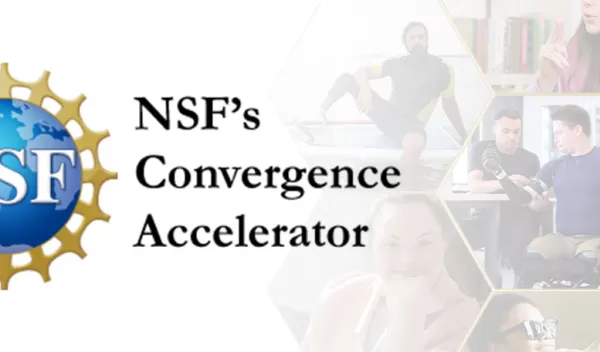
NSF advances technologies to improve quality of life for persons with disabilities
The U.S. National Science Foundation is investing in research solutions to address challenges faced by persons with disabilities, including the development of assistive and rehabilitative technologies to enhance their quality of life and provide greater opportunities for gainful employment. With a $30 million investment, NSF has selected six multidisciplinary research teams to advance from Phase 1 to Phase 2 of the NSF Convergence Accelerator's Track H: Enhancing Opportunities for Persons with Disabilities.
"Ensuring accessibility and inclusivity for persons with disabilities are both societal and economic imperatives," said Erwin Gianchandani, NSF assistant director for Technology, Innovation and Partnerships (TIP). "Disabilities that affect a person's hearing, mobility, vision, self-care, mental health and more create challenges for how they perceive, understand and engage. Through the Convergence Accelerator's Track H, we are proud to invest in tangible solutions that can have a positive and transformational impact on individuals' lives, enabling them to become equal contributors within their communities."
The NSF Convergence Accelerator track builds upon NSF's mission of accelerating convergence research, in this case across assistive and rehabilitative technologies for diverse populations of persons with disabilities. Collectively, the selected Phase 2 teams will produce systems, technologies and tools to enable persons with disabilities to gain access places, jobs and experiences. Funded solutions include improvements to text-to-speech, applications for the hearing impaired, restored limb functions for the physically impaired, increased transportation efficiency for the visually impaired and more.
"A convergence approach between researchers, innovators and persons with disabilities spanning organizations and communities across multiple sectors is crucial to ensure these NSF-funded solutions address barriers to employment, freedom of movement and quality of life for persons with disabilities," said Douglas Maughan, head of the NSF Convergence Accelerator program. "The selected Phase 2 teams are fostering strong partnerships to ensure their use-inspired solutions assist a wide range of people. At the end of Phase 2, NSF expects these teams to provide high-impact deliverables that will be sustained beyond NSF support."
To support each team's solution development, the Phase 2 teams will participate in an innovation and entrepreneurial curriculum that includes training on product development, intellectual property, financial resources, sustainability planning, communications and outreach.
Phase 2 awardees include:
- HeardAI: Led by Michigan State University, HeardAI's vision is to transform voice-artificial intelligence technology accessibility for 80 million people who stutter, then eventually benefit all users. The solution's extensible sociotechnical framework offers accessibility guidance for compliance checking, a realistic stuttered speech testbed for product evaluation, an application and an application programming interface to make voice-activated products and services accessible.
- Inclusio: Led by Saint Louis University, Inclusio is reimagining accessibility by transforming how people create and consume accessible content in classrooms, workplaces, and homes. The project aims to provide an end-to-end software platform that enables rapid sourcing and generation of accessible content that can be felt, heard, and seen across multiple platforms, with a core mission of serving those with low vision and blindness.
- MABLE: Led by Lehigh University, Mapping for Accessibility in Environments (MABLE) is providing people with disabilities independence to experience large events, conferences and educational programs. Using crowdsensing, AI and robotics, MABLE empowers individuals with a responsive map and turn-by-turn instructions through a digital app to help them navigate indoor environments successfully.
- Project DRIVE: Led by Northwestern University, Project DRIVE imagines a future where power wheelchairs are accessible to everyone that needs one. By connecting current and future technologies, the solution enables safe, independent, power wheelchair operations using intelligent robotic assistance.
- RAFAS: Led by Harvard University, Restoring Arm Function after Stroke (RAFAS) is creating an at-home rehabilitation solution to restore arm function after a stroke. RAFAS is a wearable technology that supports an end-user to practice reaching with their affected arm during daily activities while remotely monitoring recovery and providing feedback to encourage behavioral change.
- UNav: Led by the New York University Medical Center, UNav revolutionizes navigation for visually impaired users through precision localization technology that maps and provides wayfinding for both indoor and outdoor environments. As a mobile application or hands-free wearable technology, UNav communicates directions and hazards using multisensory feedback. The solution improves travel equity by cutting travel time, reducing injuries and increasing environmental awareness.
About the NSF Convergence Accelerator
Launched in 2019, the NSF Convergence Accelerator — a TIP program — builds upon NSF's investment in basic research and discovery to accelerate solutions toward societal and economic impact. The program's multidisciplinary teams use convergence research fundamentals and innovation processes to stimulate innovative idea sharing and development of sustainable solutions. For more information about the program, visit new.nsf.gov/funding/initiatives/convergence-accelerator.
About TIP
TIP harnesses the nation's vast and diverse talent pool to accelerate critical and emerging technologies and address pressing societal and economic challenges. The directorate comprises three primary focus areas: fostering innovation and technology ecosystems; establishing translation pathways; and partnering across sectors to improve U.S. competitiveness, grow the U.S. economy and engage and train a diverse workforce for future, high-wage jobs. For more information about TIP, visit new.nsf.gov/tip/latest.
